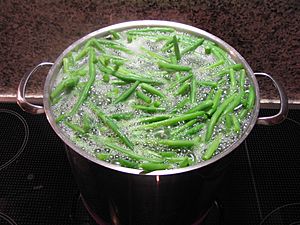Blanching (cooking) facts for kids
Blanching is a cooking method where you quickly heat food, usually vegetables or fruits. You put the food in boiling water for a short time. Then, you quickly move it to very cold water. This sudden cooling stops the cooking process right away.
Blanching helps food stay fresh and good for longer. It's often done before freezing, drying, or canning food. This process helps stop natural changes that can make food spoil. It also helps keep the food's color, taste, and healthy nutrients.
Contents
Why We Blanch Food
Blanching is mainly used to stop tiny things called enzymes from working. Enzymes can make fruits and vegetables turn brown or change their texture and taste. By blanching, we "turn off" these enzymes.
Blanching also helps make food easier to peel. For example, it can help remove the skin from tomatoes or almonds. This method is often better for the environment than other peeling ways.
Here are some other reasons why blanching is useful:
- It helps kill tiny living things (microorganisms) that can spoil food.
- It can remove leftover pesticides or other unwanted stuff from the surface of food.
- It cleans the food's surface.
- It can help get rid of damaged seeds or other unwanted bits.
- It can kill parasites and their eggs that might be on the food.
How Blanching is Done
The most common ways to blanch food are using hot water or hot steam. In both methods, the food is heated for a short time. After heating, it's quickly put into cold water or cold air. This quick cooling step is very important to stop the cooking.
In big food factories, food moves on a conveyor belt. It goes through sections for heating, holding, and then cooling.
Steam Blanching
Steam blanching uses hot steam instead of boiling water. The steam is sprayed onto the food as it moves along a conveyor belt. This method is good because it helps the food keep more of its healthy parts. Water-soluble things like some vitamins can wash away in hot water. Steam blanching uses less energy too. It also helps keep the food's color, taste, and overall quality better.
Challenges in Blanching
When blanching with hot water, some good things can get lost from the food. Vitamins, minerals, and other healthy parts can dissolve into the water. This can lower the food's overall quality. How much is lost depends on the food itself and how long it's blanched. Some vitamins, like vitamin C, are very sensitive to heat.
Also, the water used for blanching can become dirty. This dirty water needs to be cleaned before it can be thrown away. This cleaning can cost extra money for food companies. Because of this, new ways of blanching are being developed.
Images for kids
See also
 In Spanish: Escaldado para niños
In Spanish: Escaldado para niños




